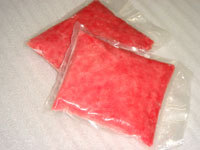Highlights and Successes
On this Page
Tennessee Detectives Investigate an Outbreak of Cryptosporidium
 In the summer of 2012, public health officials in Tennessee were notified that a group of volunteers were sick with gastroenteritis. The volunteers were from multiple states and had traveled to Tennessee to work on a farm. Tennessee officials collaborated with several other states to figure out what caused the illness. They used an online survey to collect information, but after a couple days only a few volunteers had responded.
In the summer of 2012, public health officials in Tennessee were notified that a group of volunteers were sick with gastroenteritis. The volunteers were from multiple states and had traveled to Tennessee to work on a farm. Tennessee officials collaborated with several other states to figure out what caused the illness. They used an online survey to collect information, but after a couple days only a few volunteers had responded.
FoodCORE interviewers were determined to help collect more information and called about 60 volunteers who did not answer the online survey. At the same time, laboratorians tested samples from the sick people, which came back positive for a parasite called Cryptosporidium.
FoodCORE’s direct outreach to the remaining volunteers provided the critical information needed to help solve the outbreak. Using these responses, public health officials determined that the volunteers got sick through their contact with calves while working in the barn, and not from something they ate. The barn owner conducted an extensive clean-up, and Tennessee officials shared educational information about the risks of human illness due to contact with animals and their environments. All the sick volunteers returned to their homes and recovered fully from their illness.
"Our FoodCORE interviewers contacted the volunteers, and conducted phone surveys to gather more information. This was no easy task, and without FoodCORE's help, we would not have been able to identify the source of the outbreak as quickly."
- Ellyn Marder
CDC/CSTE Applied Epidemiology Fellow, Tennessee Department of Health
Click here to view Tennessee Detectives Investigate an Outbreak of Cryptosporidium [PDF - 466 KB]
FoodCORE + U
 It’s hard to imagine that simply having students talk with patients about chicken livers, raw milk, and sprouts could help protect our food supply and save lives, but it’s true. These students have become integral in identifying the culprits in outbreaks of foodborne illness across the country.
It’s hard to imagine that simply having students talk with patients about chicken livers, raw milk, and sprouts could help protect our food supply and save lives, but it’s true. These students have become integral in identifying the culprits in outbreaks of foodborne illness across the country.
“U” niversity partnerships—at the core of FoodCORE
Student interviewers are a vital part of Foodborne Diseases Centers for Outbreak Response Enhancement, or FoodCORE, which is a program of centers that work together to develop better ways to investigate and respond to outbreaks of foodborne diseases. FoodCORE students quickly interview patients who became sick after eating contaminated food. Six out of seven FoodCORE centers hire students from nearby universities and schools of public health and train them to interview patients.
“It is very rewarding to be a part of the connection between students and the FoodCORE program. FoodCORE closes the gap between academia and the real world by providing students with valuable experiences. Students are graduating with a deeper understanding of foodborne outbreak response as well as credible references and potential job offers.”
– Amy Woron
Molecular Biologist, Tennessee State Public Health Laboratory
Adjunct Professor, Tennessee State University
You ate what?
During the interviews, students ask the patients what foods they ate before they got sick. Students often conduct interviews after regular working hours and on weekends, when patients are easier to reach.
FoodCORE program coordinators have been pleased with the students’ contributions. “The students are doing real world public health, helping prevent the spread of disease. They bring a superior level of enthusiasm to their interviews,” said Sharon Hurd, FoodCORE-Connecticut Program Coordinator.
 Since 2009, more than 64 students from 15 universities have been involved in this program. The program has had many benefits:
Since 2009, more than 64 students from 15 universities have been involved in this program. The program has had many benefits:
- Public health investigators have been able to get faster and more complete food histories, which are essential for responding to a foodborne outbreak.
- Staff at FoodCORE centers have formed vital working relationships with staff at nearby colleges and universities.
- Students gain experiences that prepare them for careers in public health.
Several student interviewers have gone on to work in public health. For example, one student is now FoodCORE-Wisconsin’s student team coordinator. Another student, who worked for FoodCORE-New York City’s team, joined CDC as an epidemiologist. A student who worked in Utah’s FoodCORE center said the experience helped him see face-to-face the people affected by disease outbreaks:
“In epidemiology, it’s easy to get lost in the numbers and statistics related to the investigation of a disease. In reality, they aren’t just numbers, they’re people, and those of us in public health have committed our lives to protecting people,” said Randy Leggett, former FoodCORE-Utah student interviewer. “I am grateful for the opportunity I had as a FoodCORE student interviewer. The experience taught me about real world enteric disease investigations and reaffirmed my dedication to public health.”
Patients who are interviewed by students might wonder, “Why is this student asking me what I ate?” The answer is simple: That student is helping to protect our food supply and save lives.
Click here to view FoodCORE + U [PDF - 1.08 MB]
Ohio Uses Social Media to Help Protect People from Norovirus

Norovirus spreads quickly, but public health experts in Ohio are even faster. FoodCORE funding has allowed Ohio’s public health laboratory to test for norovirus more frequently, which helps to confirm local outbreaks faster. In the first three months of 2012, the Ohio Department of Health confirmed that 76 outbreaks were caused by norovirus. This compares with the same three-month period in 2011, which had 35 confirmed norovirus outbreaks reported; the five-year average (2007–2011) for this three-month period was 30 confirmed norovirus outbreaks.
Public health experts reacted quickly to create a norovirus web page and use social media to teach people how to protect themselves from norovirus infection. Many people visited the web page through a mobile Facebook app. Prevention tips were also posted on the Department of Health’s Facebook and Twitter pages. The Department of Health’s social network is popular, reaching a total network of more than 400,000 Facebook users when friends of fans are included. There are 1,360 followers on Twitter. “Getting the word out using social media is a modern way to share disease prevention messages, especially about the importance of hand washing in reducing the spread of norovirus,” said Kim Quinn, Chief of the Outbreak Response and Bioterrorism Investigation Team. The best ways to help prevent the spread of norovirus are to practice proper hand washing, disinfect surfaces, and avoid caring for others or preparing food when sick.
For more information about the Ohio Department of Health’s norovirus web page, please visit: http://www.odh.ohio.gov/features/odhfeatures/norovirus.aspx
Click here to view Ohio Uses Social Media to Help Protect People from Norovirus [PDF - 347 KB]
Helping Solve Salmonella Outbreak Mysteries

Raw Scraped Ground Tuna
Foodborne Diseases Centers for Outbreak Response Enhancement (FoodCORE) played a key role in solving a 2012 multistate outbreak of Salmonella Bareilly and Nchanga infections. This outbreak was quickly detected by PulseNet, the national subtyping network made up of state and local public health laboratories and federal food regulatory laboratories that perform molecular surveillance of foodborne infections. The outbreak was widespread, with 425 ill people identified in 28 states and the District of Columbia; 55 people were hospitalized.
Ill persons were identified by five of seven FoodCORE centers. These centers contributed critical evidence to accelerate the investigation. State and local public health epidemiologists, public health nurses, and student interview teams in the centers rapidly interviewed ill people to determine their food history and quickly identified restaurants where they ate. Multiple people reported eating sushi the week before they became sick. This information was crucial to identifying which foods to test and trace back. Using interview information as well as their centers’ enhanced capabilities, environmental health specialists and laboratory personnel collected and tested food samples.
The participating FoodCORE centers worked together with other involved health departments and regulatory partners to pinpoint frozen raw scraped ground tuna as the likely source of contamination. They were among the first to identify the outbreak strains in the contaminated food. The product was recalled, which likely prevented additional illnesses.
Click here to view Helping Solve Salmonella Outbreak Mysteries [PDF - 769 KB]
New York City's "Team Salmonella" Successful in Solving an Outbreak

New York City's "Team Salmonella"
In August 2011, public health officials began an investigation into a Salmonella outbreak in which many cases resided in New York. An in-depth investigation was conducted by the New York City Department of Mental Health and Hygiene (NYCDOHMH), who is a partner in the FoodCORE project. With FoodCORE funding, NYCDOHMH is able to maintain a staff of trained student interviewers, aptly named "Team Salmonella." These students helped conduct the enhanced epidemiologic investigation among the Salmonella cases in New York City.
While the investigation was a team effort, it would not have been solved without the dedication of two students in particular, who were discussing the outbreak and the results of their interviews. These students came up with the theory that chicken livers, not specifically asked on the questionnaire, might be the cause of the outbreak. Students, FoodCORE staff, and other NYCDOHMH staff visited specialty stores where cases shopped in order to learn more about the food items available, and specifically how chicken livers were being prepared.
Suspect food items were collected for testing and the outbreak strain was found in "kosher broiled chicken liver" products. As a result, the contaminated products were recalled from grocery stores on November 8, 2011 and additional illnesses were prevented.
Click here to view New York City's "Team Salmonella" Successful in Solving an Outbreak [PDF - 759 KB]
Utah Solves a Two-year Outbreak Mystery

Blocks of Queso Fresco Cheese
For over 2 years, public health officials in Utah struggled with a Salmonella outbreak linked to queso fresco. But by using FoodCORE resources to conduct an investigation training exercise, interdisciplinary teams identified the outbreak strain of Salmonella in queso fresco and determined who produced the cheese, thus solving the food safety mystery. Currently, Utah's officials are working with regulatory and law enforcement partners to take action against the distributor to prevent future illnesses.
Click here to view Utah Solves a Two-year Outbreak Mystery [PDF - 844 KB]
Contact Us:
- Centers for Disease Control and Prevention
1600 Clifton Rd
Atlanta, GA 30333 - 800-CDC-INFO
(800-232-4636)
TTY: (888) 232-6348 - cdcinfo@cdc.gov





